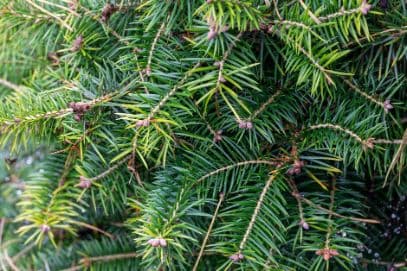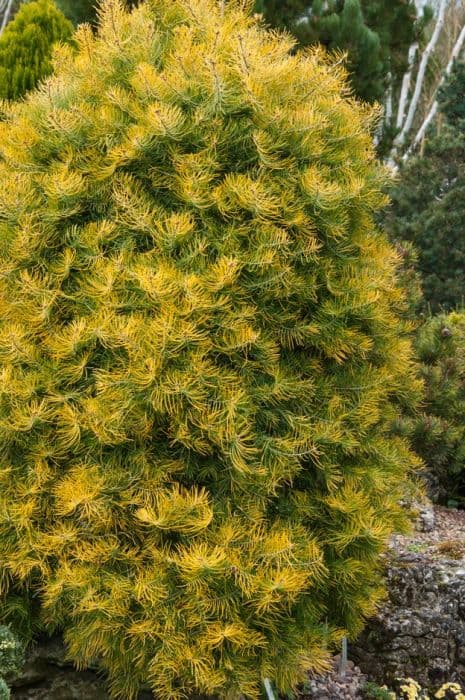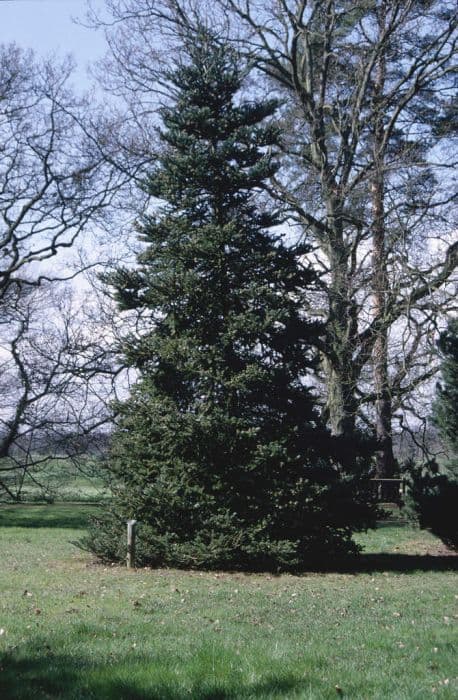Macedonian Pine Pinus peuce

ABOUT
The Macedonian pine, known as Pinus peuce, is an evergreen conifer characterized by its striking appearance, contributing to its popularity in large gardens and parks. The tree possesses a dense, pyramidal form when young, which gradually develops into a more rounded or umbrella-like shape with age. Its bark is thick and rough, often displaying deep fissures, and presents a gray to silvery-brown color that provides a rustic appeal. One of the most distinct features of the Macedonian pine is its foliage. The needles are long, slender, and flexible, presented in bundles of five. They are of a glossy, dark green color that remains vibrant throughout the year, offering a stark contrast against winter landscapes. This tree is adorned with robust cones that are elongated and cylindrical, stretching on the branches. They start out as purple, maturing to a brown color, and generally appear in clusters. These cones can add a decorative touch to the tree through various seasons as they take time to mature. Overall, the appearance of the Macedonian pine is one of stately elegance, with a lush canopy of needles providing a haven of shade and a strong, sturdy presence within its natural or landscaped setting. This pine species adds year-round interest with its textured bark, attractive foliage, and persistent cones.
About this plant
 Names
NamesFamily
Pinaceae.
Synonyms
Macedonian Pine, Balkan Pine, Peuce.
Common names
Pinus peuce.
 Toxicity
ToxicityTo humans
The Pinus peuce, commonly known as Macedonian pine, is generally not considered toxic to humans. There are no well-documented cases of poisoning from ingesting parts of this plant. In general, many species of the pine family are not toxic and are sometimes used in culinary applications, such as making pine nut products. However, it is always advisable to exercise caution and avoid ingesting plant matter unless it is known to be safe and is prepared properly.
To pets
Macedonian pine, also referred to as Pinus peuce, is not known to be toxic to pets. This includes both dogs and cats. Though not toxic, if pets ingest large quantities of pine needles or other parts of the pine tree, it may lead to gastrointestinal irritation or blockage due to the indigestible nature of the plant material. As with humans, it is generally recommended to prevent pets from consuming plants not meant for their consumption.
 Characteristics
CharacteristicsLife cycle
Perennials
Foliage type
Evergreen
Color of leaves
Green
Height
60 feet (18 meters)
Spread
20 feet (6 meters)
Plant type
Tree
Hardiness zones
4
Native area
Balkans
Benefits
 General Benefits
General Benefits- Erosion Control: Pinus peuce, commonly known as Macedonian pine, has a strong root system that helps stabilize the soil, preventing erosion on slopes and in mountainous regions.
- Habitat for Wildlife: This tree species offers habitat and nesting sites for various birds and mammals, playing a key role in maintaining biodiversity.
- Ornamental Use: Macedonian pine is often used in landscaping and garden design due to its attractive pyramidal shape and evergreen foliage.
- Timber Production: The wood of Pinus peuce is valued for its quality and is used in construction, furniture making, and as a source of pulp for paper production.
- Cultural and Historical Significance: The tree has a significant role in local traditions and history in its native regions, contributing to cultural heritage.
- Recreational use: Areas with stands of Macedonian pine often serve as recreational spaces for activities such as hiking, bird-watching, and enjoying nature.
- Climate Resilience: Being native to high altitudes, Macedonian pine can tolerate cold temperatures and is an important species for reforestation in suitable climates to combat climate change impacts.
 Medical Properties
Medical Properties- Antiseptic: Pinus peuce essential oil has been used for its antiseptic properties.
- Respiratory Support: The plant has been traditionally used to aid in respiratory issues due to its expectorant properties.
- Anti-inflammatory: Compounds found in Pinus peuce may help in reducing inflammation.
 Air-purifying Qualities
Air-purifying QualitiesThis plant is not specifically known for air purifying qualities.
 Other Uses
Other Uses- Woodworking: The Macedonian pine's wood is valued for its tight grain, which makes it suitable for fine woodworking, carving, and cabinetry.
- Resin Extraction: Resin from the tree is collected for the production of turpentine and rosin used in various industries such as adhesives and varnishes.
- Christmas Trees: Due to its attractive form and foliage, Macedonian pine is sometimes cultivated and sold as a Christmas tree, especially in Europe.
- Park and Garden Planting: This species is often planted as an ornamental tree in parks and gardens for its aesthetic appeal.
- Erosion Control: Its root system is effective in stabilizing soils, making it an important species for erosion control on slopes and in ravine areas.
- Windbreaks and Shelterbelts: Macedonian pine is used in forestry plantings to create windbreaks and shelterbelts, which protect crops and soil from wind erosion.
- Ski Slopes: The trees are sometimes planted alongside ski slopes to reduce wind speed and prevent snow drifts.
- Habitat Support: The tree provides habitat and food for a variety of wildlife, including nuts for small mammals and a canopy for birds.
- Bonsai Cultivation: The unique characteristics of Macedonian pine make it a candidate for bonsai cultivation, where it is shaped into miniature forms.
- Education and Research: Due to its distinct features, Macedonian pine is used in dendrological studies to provide education and insights into conifer growth and ecology.
Interesting Facts
 Feng Shui
Feng ShuiThe Macedonian Pine is not used in Feng Shui practice.
 Zodiac Sign Compitability
Zodiac Sign CompitabilityThe Macedonian Pine is not used in astrology practice.
 Plant Symbolism
Plant Symbolism- Longevity and Endurance: Pinus peuce, commonly known as Macedonian Pine, is a long-lived species, often symbolizing longevity and the ability to withstand challenges over time.
- Resilience: The Macedonian Pine's ability to grow in challenging environments and withstand cold temperatures represents resilience and adaptability.
- Wisdom: Trees are often associated with wisdom, and the Macedonian Pine, with its long lifespan, can symbolize the accumulation of knowledge and experience over the years.
- Stability: With its sturdy trunk and deep roots, the Macedonian Pine can represent stability, security, and grounding in one's beliefs or values.
 Water
WaterThe Macedonian pine should be watered deeply every few weeks, allowing the soil to dry out between waterings. In the absence of rain, this might translate to about 2 gallons for young trees, increasing up to 10 gallons for mature trees, every two to three weeks during the growing season. Reduce watering frequency in the winter, as the tree requires less moisture during dormant periods.
 Light
LightThe Macedonian pine flourishes best in full sun, so it should be planted in a location where it can receive direct sunlight for at least six hours a day. An open area without shade from buildings or taller trees is ideal for healthy growth.
 Temperature
TemperatureThe Macedonian pine is capable of withstanding a wide range of temperatures, from a minimum of around -30°F to a maximum of around 100°F. However, the ideal temperature range for this tree is between 60°F and 75°F, which encourages healthy growth.
 Pruning
PruningPruning the Macedonian pine is mainly for shaping and removing damaged or diseased branches. It's best done in late winter or early spring, before new growth begins. Pruning is not frequently required and should be done conservatively, as pines do not regrow from old wood. The practice every few years is generally sufficient unless there is specific damage or disease to address.
 Cleaning
CleaningNot needed
 Soil
SoilMacedonian pine thrives best in well-draining, acidic soil with a pH range of 5.5 to 7.0. A mixture of sandy loam, peat, and pine bark is ideal to ensure proper drainage and mimic its natural growing conditions. Adequate organic matter will help support its growth.
 Repotting
RepottingMacedonian pine should be repotted every 2 to 3 years, especially while it's young and growing rapidly. Older trees can be repotted less frequently, as infrequently as every 4 to 5 years, as their growth rate slows down.
 Humidity & Misting
Humidity & MistingMacedonian pine does not require high humidity levels and is well-adapted to outdoor conditions where the humidity is naturally variable. It can tolerate a wide range of humidity levels typical of temperate climates.
 Suitable locations
Suitable locationsIndoor
Ensure bright light, cooler temps, and good airflow for Macedonian pine.
Outdoor
Plant Macedonian pine in full sun, well-drained soil, and shelter from winds.
Hardiness zone
4-7 USDA
 Life cycle
Life cyclePinus peuce, commonly known as Macedonian pine, begins its life cycle as a seed, which after dispersal germinates in favorable conditions, typically in well-drained soil. Upon germination, the seedling emerges, characterized by the growth of its initial roots and shoots. As it enters the sapling stage, the young Macedonian pine develops a sturdy stem, a root system for nutrient uptake, and needles for photosynthesis. After several years, it reaches maturity and starts to produce its reproductive structures, cones, with the tree being able to live for many years before reaching this reproductive stage. Male cones release pollen that is carried by the wind to fertilize female cones, which after pollination develop seeds. Finally, as an evergreen, this pine continually grows and can produce cones annually for many years, with individual trees living for several centuries under optimal conditions.
 Propogation
PropogationPropogation time
Spring to Summer
The most popular method of propagation for Pinus peuce, commonly known as Macedonian pine, is by seed. The optimal time for sowing seeds is during late winter or early spring. Seeds should be cold stratified at approximately 34 to 41 degrees Fahrenheit (1 to 5 degrees Celsius) for 60 to 90 days to break dormancy, after which they can be sown in a well-draining seed starting mix. Planting depth should be shallow, generally around 1/4 to 1/2 inch (about 6 to 12 mm) deep, and seeds should be kept moist until germination, which may take several weeks to months. Seedlings require sunlight and should be protected from extreme elements until they are strong enough to be transplanted to a permanent location.









